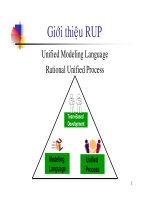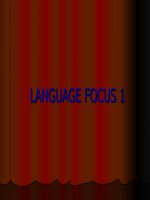7.unified modeling language (uml)
Bạn đang xem bản rút gọn của tài liệu. Xem và tải ngay bản đầy đủ của tài liệu tại đây (189.2 KB, 57 trang )
The Unified Modeling
Language (UML)
It is a standardized general-purpose
graphical language for modeling
object-orient ed software.
This was developed in 1990¶s by
Object Management Group.
It combines the ideas of Rumbaugh,
Booch and Jacobson and hence the name
µUnified¶ modeling language.
Programmers, software architects, and
analysts use modeling languages such
as UML to graphically describe the
design of a software.
The UML defines a variety of
diagrams such as class diagrams,
use-case diagrams, interaction
diagram, statechart diagrams,
activity diagrams etc.
This language is sufficient ly
general to be used in all softw are
engineering domains.
UML Class Diagrams
It gives an overview of a system
by showing its classes and the
relationships among them.
These diagrams show the static
structure of the model.
The main symbols shown on a class
diagram are:
Classes
Associations
Attributes
Operations
Generalisation
Representation of a Class
A class is represented as a box
with the name of t he class inside.
This box can have three
compartments first for
represent ing the name of the
class, second for the attributes
and third for operat ions.
These compartments may be omitted
to simplify the diagrams.
and operations of a class can also
be represent ed in a class notation
using -, # and + symbols. The
hyphen (-) means private, the
pound sign (#) means protected,
and plus (+) means public (see the
following figure).
Association
An association is a relationship
between two classes and is shown
by a solid line between two
classes.
The instance of an association is
known as a link.
Therefore an association is a
group of links with common
structure and common semant ics.
An association also represents
multiplicity or cardinality.
The multiplicity indicates how
many objects of the class at one
end of the association can be
linked to a single instance of the
class at the other end of the
association.
There are three types of
multiplicity across an
association.
One-to-one
One-to-many
Many-to-many
The multiplicity is represented as:
lowerbound upperbound
Eg:
1 means exactly one
0 1 zero or one
* from zero to any
positive integer
0 * from zero to
any
positive integer
1 * from one to any
positive integer
An associat ion can be labeled by
placing an association name in the
middle of the association or by
placing the role name either or
both ends of the association.
If no association name or role
name is specified, then the
default association name µhas¶ is
assumed.
Aggregation is an association in
which one class belongs to a
collection.
Example :- Order has a collection
of OrderDetails.
It is represented by a diamond
symbol placed next to the
aggregate.
Aggregat ions are special
associat ions that represent a µhas
a¶ or a µwhole/part¶ relationship
among peers.
Sometimes an aggregation relation
may be a strong aggregation.
The parts cannot have a life of
their own.
It means that if the aggregate is
destroyed, then the parts also
destroyed.
A strong aggregation is also known
as a composition.
A strong aggregation is
represented by a solid diamond
symbol.
The generalizat ion is the
relationship between a more
general class and a more specific
class.
It is represented by a small
triangle pointing to the general
class. They must follow the ³is a´
rule.
A use case is a typical sequence
of actions that an actor performs
in order to complete a given task.
It describes the behavior of the
system from a users point of view
by using actions and reactions.
An actor is role that a user or
some other system plays when
interact with your system.
Symbols Used in Use
Cases
Before drawing a use case diagram, a scenario must be created.









